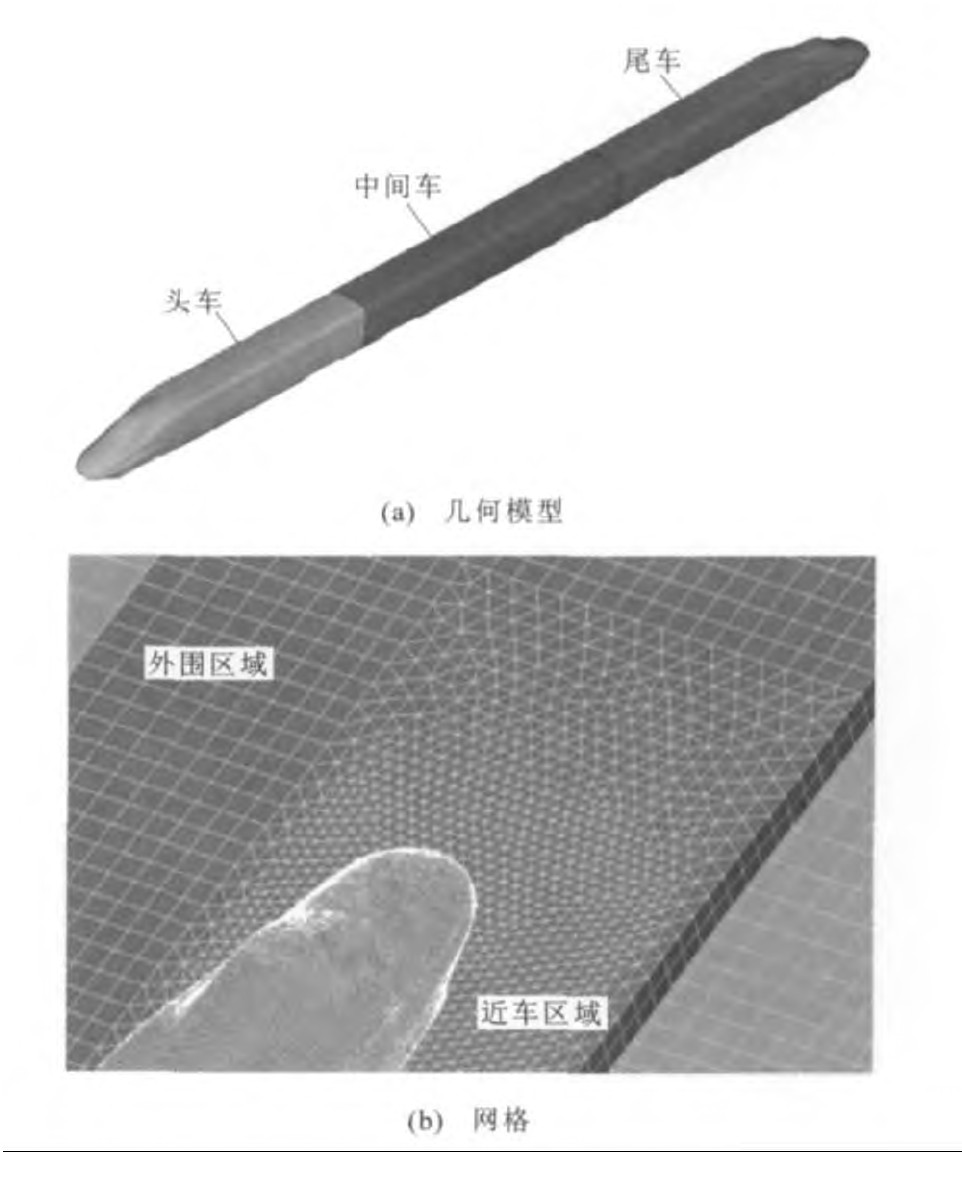Calculation method of cross wind security domain for high-speed train
-
摘要: 使用参数传递、求解控制以及动态网格技术, 建立了侧风流体动力学模型和高速列车多体动力学模型, 通过对列车外流场和系统响应进行协同仿真, 获得不同侧风环境下列车的稳定姿态和气动载荷, 研究了列车运行的安全性指标, 分析了不同侧风环境下列车安全运行的临界速度, 确定了列车的侧风作用安全域。计算结果表明: 随着列车运行速度和侧风强度的增大, 轮重减载率、脱轨系数和轮轴横向力依次出现超限现象; 当列车运行速度小于300 km·h-1时, 列车头车所有轮对均逆风向偏移; 当列车运行速度为300 km·h-1且侧风风速为30 m·s-1以及列车运行速度为350 km·h-1且侧风风速不小于25 m·s-1时, 一、二位轮对顺风偏移, 三、四位轮对逆风偏移; 列车运行速度越高, 抵抗侧风能力越低, 且列车临界速度对侧风强度的敏感性增大。Abstract: Based on parameter transmission, solution to control and dynamic mesh techniques, the cross wind fluid dynamics model and the multi-body system dynamics model of high-speed train were established.By collaboratively simulating the external flow field and system response of train, the stable attitudes and aerodynamic loads under different cross wind environments were obtained.The running safety indexes were studied, the critical speeds of running safety under different cross wind environments were analyzed, and the security domain was defined.Calculation result indicates that with the increases of train speed and cross wind strength, the transfinite phenomena of wheel unloading rate, derailment coefficient and lateral wheelset force appear successively.While train speed is less than 300 km·h-1, all wheelsets of leading vehicle almost have upwind migration.While train speed is 300 km·h-1 and cross wind speed is 30 m·s-1, and train speed is 350 km·h-1 and cross wind speed is more than 25 m·s-1, the first and second wheelsets have downwind migration, the third and fourth wheelsets have upwind migration.The higher train speed is, the lower the cross wind resistance ability is, and the sensitivity of train critical speed on cross wind strength will increase.
-
Key words:
- high-speed train /
- aerodynamics /
- security domain /
- cross wind /
- attitude change /
- collaborative simulation
-
表 1 气动载荷对比
Table 1. Comparison of aerodynamic loads

表 2 安全性指标对比
Table 2. Comparison of safety indexes

-
[1] CARRARI NI A. Reliability based analysis of the cross-wind stability of rail way vehicles[J]. Journal of Wind Engineering and Industrial Aerodynamics, 2007, 95(7): 493-509. doi: 10.1016/j.jweia.2006.10.001 [2] SUZUKI M, TANEMOTO K, MAEDA T. Aerodynamic characteristics of train/vehicles under cross winds[J]. Journal of Wind Engineering and Industrial Aerodynamics, 2003, 91(1): 209-218. [3] SANQUER S, BARRE C, DUFRESNE DE VIREL M, et al. Effect of cross winds on high-speedtrains: development of a new experimental methodology[J]. Journal of Wind Engineering and Industrial Aerodynamics, 2004, 92(7/8): 535-545. [4] KHIER W, BREUER M, DURST F. Flow structure around trains under side wind conditions: a numerical study[J]. Computers and Fluids, 2000, 29(2): 179-195. doi: 10.1016/S0045-7930(99)00008-0 [5] XU Y L, DI NG Q S. Interaction of rail way vehicles with track in cross-winds[J]. Journal of Fluids and Structures, 2006, 22(3): 295-314. doi: 10.1016/j.jfluidstructs.2005.11.003 [6] BAKER C. The flow around high speed trains[J]. Journal of Wind Engineering and Industrial Aerodyanmics, 2010, 98(6/7): 277-298. [7] BAKER C J, JONES J, LOPEZ-CALLEJA F, et al. Measurements of the cross wind forces on trains[J]. Journal of Wind Engineering and Industrial Aerodynamics, 2004, 92(7): 547-563. [8] 崔涛, 张卫华. 基于姿态变化的列车侧风安全性研究[J]. 铁道学报, 2010, 32(5): 25-29. https://www.cnki.com.cn/Article/CJFDTOTAL-TDXB201005006.htmCUI Tao, ZHANG Wei-hua. Study on safety of train in side wind with changing attitudes[J]. Journal of the China Rail way Society, 2010, 32(5): 25-29. (in Chinese) https://www.cnki.com.cn/Article/CJFDTOTAL-TDXB201005006.htm [9] 任尊松, 徐宇工, 王璐雷, 等. 强侧风对高速列车运行安全性影响研究[J]. 铁道学报, 2006, 28(6): 46-50. doi: 10.3321/j.issn:1001-8360.2006.06.008REN Zun-song, XU Yu-gong, WANG Lu-lei, et al. Study on the running safety of high-speed trains under strong cross winds[J]. Journal of the China Rail way Society, 2006, 28(6): 46-50. (in Chinese) doi: 10.3321/j.issn:1001-8360.2006.06.008 [10] 黄林, 廖海黎. 横向风作用下高速铁路车桥系统绕流特性分析[J]. 西南交通大学学报, 2005, 40(5): 585-590. doi: 10.3969/j.issn.0258-2724.2005.05.004HUANG Lin, LIAO Hai-li. Analysis of flow characteristics around high-speed rail way bridge-vehicle system under cross wind[J]. Journal of Southwest Jiaotong University, 2005, 40(5): 585-590. (in Chinese) doi: 10.3969/j.issn.0258-2724.2005.05.004 [11] 高广军, 田红旗, 姚松, 等. 兰新线强横风对车辆倾覆稳定性的影响[J]. 铁道学报, 2004, 26(4): 36-40. doi: 10.3321/j.issn:1001-8360.2004.04.008GAO Guang-jun, TIAN Hong-qi, YAO Song, et al. Effect of strong cross-wind on the stability of trains running on the Lanzhou-Xinjiang Rail way Line[J]. Journal of the China Rail way Society, 2004, 26(4): 36-40. (in Chinese) doi: 10.3321/j.issn:1001-8360.2004.04.008 [12] 崔涛, 张卫华, 张曙光, 等. 列车高速通过站台时的流固耦合振动研究[J]. 中国铁道科学, 2010, 31(2): 50-55. https://www.cnki.com.cn/Article/CJFDTOTAL-ZGTK201002013.htmCUI Tao, ZHANG Wei-hua, ZHANG Shu-guang, et al. Study on the fluid-solid coupling vibration of train passing through platform at high speed[J]. China Rail way Science, 2010, 31(2): 50-55. (in Chinese) https://www.cnki.com.cn/Article/CJFDTOTAL-ZGTK201002013.htm [13] 毕海权, 雷波, 张卫华. 高速磁悬浮列车会车压力波数值计算研究[J]. 空气动力学学报, 2006, 24(2): 213-217, 237. doi: 10.3969/j.issn.0258-1825.2006.02.014BI Hai-quan, LEI Bo, ZHANG Wei-hua. Numerical study of the pressure load caused by high-speed passing maglev trains[J]. Acta Aerodynamica Sinica, 2006, 24(2): 213-217, 237. (in Chinese) doi: 10.3969/j.issn.0258-1825.2006.02.014 [14] 章亮, 王林栋, 黄欣, 等. 动车组动力学响应测试在联调联试中的应用[J]. 铁道机车车辆, 2011, 31(1): 41-44. https://www.cnki.com.cn/Article/CJFDTOTAL-TDJC201101010.htmZHANG Liang, WANG Lin-dong, HUANG Xin, et al. Importance of EMU dynamic response test in systems integration test[J]. Rail way Loco motive and Car, 2011, 31(1): 41-44. (in Chinese) https://www.cnki.com.cn/Article/CJFDTOTAL-TDJC201101010.htm -





 下载:
下载:













